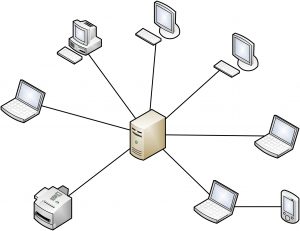A server is a program or a hardware whose job is to accept the request from a client and give the data or service over the network (LAN or WAN) in response to the client requests.
Simply put, a server is a computer which serves the request of any other computer(client) in a network. The request might be of a webpage or some other service.
Common Type of Servers
While some dedicated servers, such as a print server or database server, concentrate on one task, other implementations use one server for multiple purposes.
A large, general-purpose network that serves a medium-sized company would like to deploy multiple server types including:
| Web Server | A web server displays pages and executes apps via web browsers. The server to which your browser is now linked is a web server that contains this page and the photos on it. For this case, the client program is a browser such as Internet Explorer, Chrome, Firefox, Opera, or Safari. Web servers are used for many tasks in addition to deliver simple text and images, for example uploading and saving files online through a cloud storage service or online backup service. |
| Email Server | The use of email servers is to send and receive email messages. If you have an email client on your computer, the software connects to an IMAP or POP server to download your messages to your PC, and an SMTP server for sending back messages from the email server. |
| FTP Server | It uses File Transfer Protocol to transfer files. FTP servers are remotely accessible through FTP client programs that connect to the server’s file sharing, either via built-in FTP functionality of the server or through a special FTP server program. |
| Identity | Identity servers support logins and security roles for authorized users. |
Hundred of specialized types of servers assist computer networks. Besides, home users also communicate with online game servers, chat servers, and audio and video streaming servers, among others.
How does Servers work

To understand a server’s operation, you should first understand the browser-web server connection.
When you are using a browser, you type in the address or URL of the website you want to go to. Then firstly, that request will get the DNS (Domain Name System). In DNS, the URL will be converted into the IP address.
Every single Internet-connected device has their own unique IP address. IP address is basically the identification of the devices over the internet.
After the IP address associated with that URL or Web page is obtained. The request is forward to the relevant Web Server. Then, the web server takes a request and gathers the web page data or elements. Thus the server begins transmitting the requested web page in response to the client request. Then, the web browser receives the requested page and displays it to the user. So, this is the overall process behind the interaction between client and server.
You must wonder how a server fetches requests every second. This is possible with the support of powerful hardware and software (Linux Distribution) built on the servers. Unlike our old computers, it uses RAID (Redundant Array of Independent Disks), a special storage technology. The advantages of using RAID is that it reduces the risk of data loss. In RAID, multiple disks store the same data. Even if one disk gets malfunctioned or stop working anyhow. Then, there will be the other one to replace it without interrupting data flow or any loss of data.
More Information on Servers
Uptime is very important for most servers, they are not built to shut down but to run 24/7 instead. Occasionally, however, servers go down deliberately for scheduled maintenance. Hence, some websites and services warn user of scheduled downtime and maintenance. Besides that, server could also go down during something like a DDoS attack.
Web server usually reports an error due to downtime – whether intentional or not – can do so using standard HTTP status code.
If a web server takes information down temporarily or permanently, you might still be able to access those files if it was archived by a third-party service. Wayback Machine is an example of a web archiver that stores snapshots of web pages and Web server archives.
Large businesses with many servers usually do not access these servers locally, like with a keyboard and mouse, but by remote access instead. Such servers are also called virtual machines, which means that one storage system can host several servers, saving both physical and money.


